Ginger plants are tropical flowering plants with rhizomes. They are a great addition to both indoor and outdoor spaces. Though these plants are quite hardy, they can face different hurdles while growing.
Some common problems ginger plants face are curly and discolored leaves, dying plants, no growth, and pests and diseases. If left untreated, some of these issues can hamper the harvest. Identifying the exact problem and taking the right steps to fix it will help your ginger thrive again.
Today, we will take you through every problem ginger plants might face and how you can encounter and reverse the damage and fix your ginger plants. So, without further delay, let’s begin.
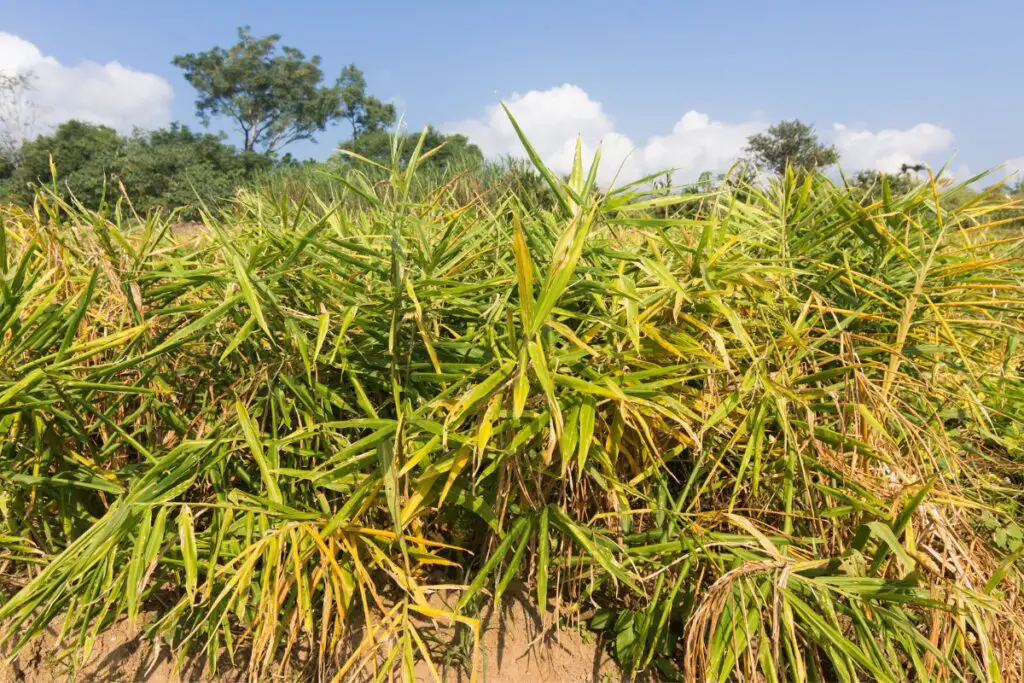
Ginger plant issues
Ginger plants can tolerate different conditions and thrive, but some situations bring trouble for the plants.
Let’s discuss the common ones, so you know how to deal with them.
1. Ginger plant leaves curling.
The common cause behind leaf curling is bacterial wilt or green wilt.
A common sign of bacterial wilt is the green leaves start curling and rolling.
The lower leaves first start showing the curling and rolling signs.
The leaves become yellow or brown within 3-5 days as the disease spreads.
The young shoots become soft, rot, and break and fall off the rhizomes.
Due to this disease, ginger will have stunted growth and watery grayish-brown color on the rhizomes and the stems.
To confirm the infection, cut a small portion at the stem.
A thick, slimy potion emerges from the stems if your plant is infected.
Reasons and solutions
The main cause of this disease is the pathogens present in the soil.
Maybe the previous crops grown were affected by the disease, and you have planted ginger in the same place.
Consider crop rotation, or make sure that the previously grown crops are not present in the location.
You can plant ginger crops in hills or raised beds.
It’s a good way to prevent diseases from occurring.
If you have planned to plant ginger, start planting mint, lemongrass, or palmarosa before ginger.
After that, plow the soil so that the essential oils get released into the soil.
These oils can kill the remaining pathogens that can cause the disease.
There is no specific treatment for this disease.
Prevention is the only way out.
So, be careful before planting your crops.
Plant seeds treated with Streptocycline.
Remove the affected plants and drench the soil bed with 0.2% copper oxychloride.
If the disease has occurred, destroy the plant.
Looking for gardening supplies? We have tested 100's of products before recommending them to you guys. Check out our best pick below:
| Image | Gardening Supplies | Best Price? |
|---|---|---|
 Top
Top Top
Top | Raised Garden Bed Kit | Check On Amazon |
 | XLUX Soil Moisture Meter, Plant Water Monitor, Soil Hygrometer Sensor for Gardening, Farming, Indoor and Outdoor Plants, No Batteries Required | No Results |
 Top
Top Top
Top | 82 Pcs Garden Tools Set and Extra Succulent Tools Set | Check On Amazon |
 | Joeys Garden Expandable Garden Hose with 8 Function Hose Nozzle, Lightweight Anti-Kink Flexible Garden Hoses, Extra Strength Fabric with Double Latex Core, (50 FT, Black) | No Results |
 Top
Top Top
Top | Dual Chamber Compost Tumbler | Check On Amazon |
 Top
Top Top
Top | Sunnyglade Plant Stakes | Check On Amazon |
 Top
Top Top
Top | Organic Cold Pressed Neem Seed Oil | Check On Amazon |
 Top
Top Top
Top | Mighty Mint Gallon :-Insect and Pest Control Peppermint Oil | Check On Amazon |
 Top
Top Top
Top | Scotts DiseaseEx Lawn Fungicide | Check On Amazon |
 Top
Top Top
Top | Jacks Classic 20-20-20 All Purpose Fertilizer | Check On Amazon |
 Top
Top Top
Top | 30,000 Seeds Pollinator Attracting Wildflower Mixture | Check On Amazon |
 Top
Top Top
Top | Survival Vegetable Seeds Garden Kit-Over 16,000 Seeds | Check On Amazon |
2. Ginger plant turning yellow
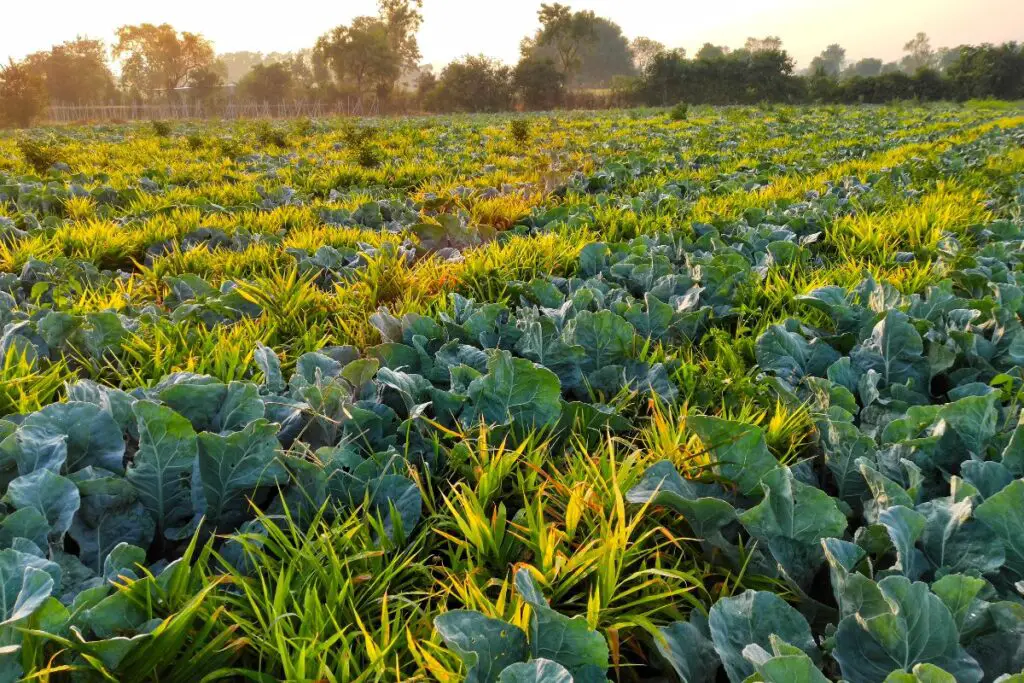
When ginger plants have yellow leaves, they are troubled by pests or diseases.
Let’s learn the problems and solutions.
Bacterial wilt
I have already mentioned it earlier.
The disease causes the green leaves to wilt and roll.
The leaves become yellow or brown, and the plant stunts.
Ensure the soil has proper drainage or plant the gingers in raised beds or hills.
Fusarium yellow
Another situation where the leaves can turn yellow is Fusarium yellow.
It also causes yellow leaves and stunted growth.
The lower leaves will dry out and then spread slowly to the plant.
If the disease has progressed too much, the plant will die before its harvesting time.
Remove and destroy the plant.
Since the signs of Fusarium yellow and bacterial wilt are similar, the difference is spotted in the leaves.
The leaves wilt in bacterial wilt, but fusarium yellow only turns the leaves yellow.
Consider crop rotation and plant disease-free seeds to prevent the disease.
Dry rot
In dry rot, the leaf tips of the ginger plants become yellow.
Once the disease increases, the leaves on the plant’s top areas will slowly turn yellow.
Slowly, the plant dries out and stops developing.
The rhizomes develop brown rings.
The reason is excessive moisture content.
Ginger enjoys moist conditions, but no plant tolerates sitting over a pool of water.
There is no proper cure for the problem.
So, plant seeds or rhizomes treated with hot water. Always check the moisture level before watering.
Before planting, add 40kg of mustard oil cake 40kg per hectare.
Rhizome rot
Another situation where leaves turn yellow is rhizome rot or Pythium rot.
The rotting causes yellow leaves and stems, stunted growth, soft and black roots, and rotted rhizomes releasing a bad odor.
The reason for this condition is wet and humid situations.
You can treat the problem by using fungicides.
Use treated seeds or plant ginger over the hills or in raised beds to avoid water accumulation and prevent rotting.
If your plant is infected, isolate the plant and remove the infected leaves and stems to prevent the spreading.
Treat the rhizomes with 2g Bordeaux or copper oxychloride per liter of water and Trichoderma with 8-10gms per liter of water.
Other ways to prevent the disease are by controlling the weed growth and considering crop rotation yearly.
White grub
Yellowing can also be a sign of white grub infestation.
The insects feed on the rhizomes and create big holes in the rhizomes.
The leaves begin to turn yellow and slowly die.
The adult ones are dark brown, and the young larvae are white that stay mostly in the soil.
To fix the issues, use Neem oil or vegetable fungicide to spray over the infected parts of the plant.
Add plants like maize, onion, sorghum, sunflower, etc., to repel the bugs.
Ginger is ready for harvest.
When ginger is ready to harvest, the leaves and stems will completely become yellow or brown.
It implies that it’s time to pick up the rhizomes.
Consider checking the rhizomes ones.
Since there are so many causes behind the yellowing of leaves, confirmation is important.
If everything is fine and the rhizomes have reached a proper size and are healthy, dig them up from the soil.
3. Ginger plant turning brown.
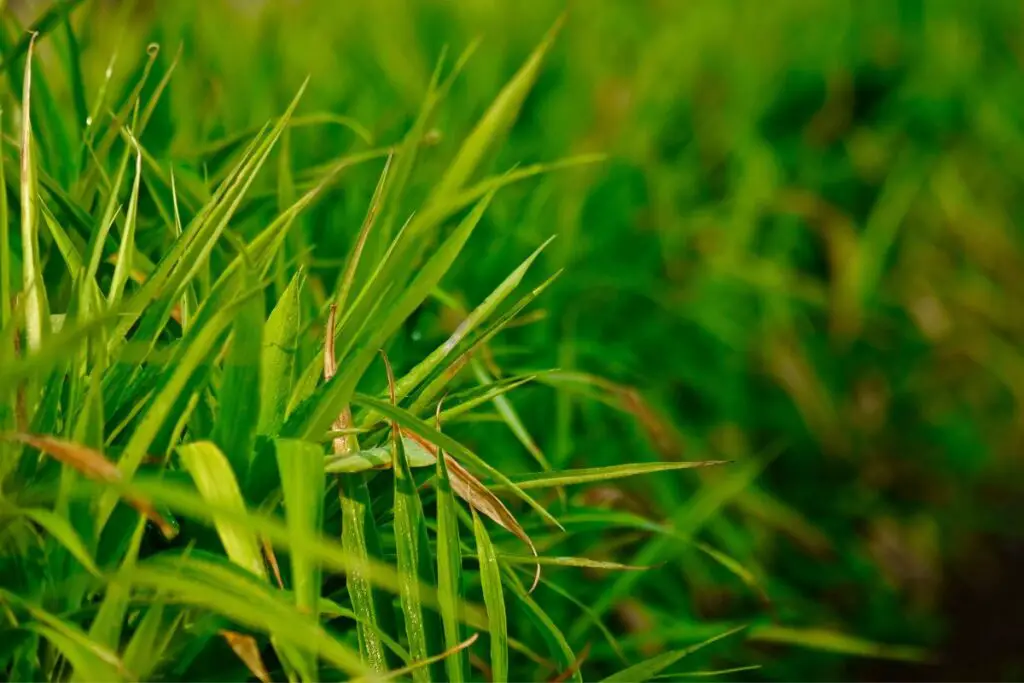
Watching the leaves turn brown suddenly is alarming.
But, it doesn’t always mean that the plant is dying or having some serious issues.
You can fix these problems and bring your plant back.
Let’s look into the reasons:
Light
Ginger plants enjoy tropical climates where the surrounding is hot and humid with temperatures between 75-85°F, but they hate direct sunlight.
Direct sunlight makes the leaves brown at the edges, dried out, and papery.
The plant will wilt and die.
Ginger thrives best under partial shade or filtered and dappled sunlight.
Add a shading net if you find out that the plant is under the sun with these signs.
Put some big potted plants near them to guard against the sunlight.
Plant ginger under or near tall trees and buildings to partially block sunlight.
Once the affected plant receives proper shade, it will return to normal.
Also read: How Much Light Does A Ginger Plant Need?
Lack of moisture
Ginger plants need a lot of moisture to develop well and thrive in the long run.
But, lack of moisture can turn the leaves brown.
Ginger cannot withstand droughts.
Water the plant whenever the soil surface has dried out.
Don’t let the whole soil dry out.
Maintain consistently moist soil throughout the year to keep the ginger leaves green.
Belonging to tropical climates, ginger plants will love 70-80% humidity levels.
The problem mainly occurs when ginger is grown inside.
To correct the humidity indoors:
- Fix humidifiers
- Use pebble trays under the pots
- Keep water tanks or trays around the plant
- Mist regularly.
You can also use some of these techniques for outdoor ginger plants.
You can try mulching for outdoor gingers.
It doesn’t allow the moisture to evaporate from the soil easily, thus maintaining the moisture levels.
Fertilization
The leaf edges look brown and burnt, and the centers are yellow.
Your plant has a nutrient deficiency.
Ginger needs to be fertilized every month during the growing season when new shoots appear.
You can use 10-20-20 fertilizer.
Add compost before planting or well-rotted chicken manure 2-3 times a year.
Use gypsum to give the plants enough calcium and sulfur.
Add seaweeds or fish emulsion every 6-8 weeks.
At the same time, you need to be careful about over-fertilization.
Ginger likes to be fed doesn’t mean you should feed them too much.
That also leads to brown leaf tips and edges.
So, be careful while applying.
If you use rotten manures, let them age for 3-6 months.
Otherwise, fresh manure will burn the plant roots.
Also read: How To Fertilize Ginger?
Dormancy
Ginger goes dormant in two situations – lack of moisture and winter seasons.
The ginger leaves will become brown in winters, and the plant will die.
But the rhizomes will be alive and dormant under the ground.
Make sure to water the plant in time, at least once weekly.
Maintain proper humidity and mist them regularly to keep them close to the water source.
Sickness
Ginger plants will have brown leaves due to several illnesses.
Diseases like Bacterial wilt, ginger Leaf blight, and Fusarium yellow first turn the leaves yellow and brown.
Prevention is the only way.
Consider crop rotation and plant good quality and disease-free seeds.
If the plant gets infected by any such diseases, destroy them immediately.
4. The ginger plant has stunted growth.
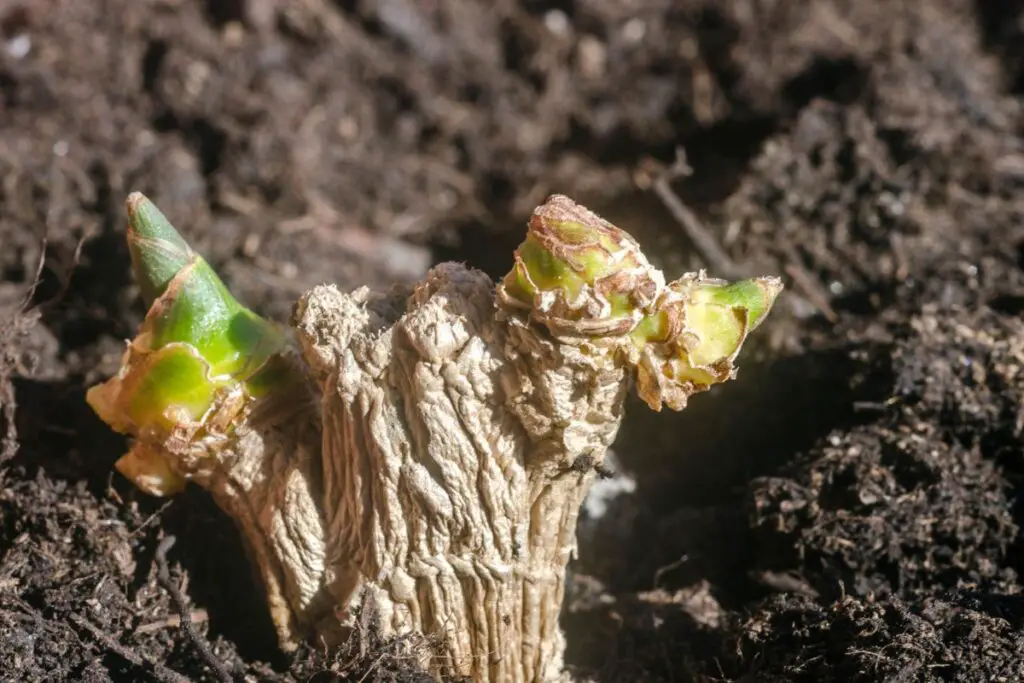
The common reasons are diseases.
The first reason behind stunted growth is Fusarium yellow.
The disease starts affecting the lower leaves first by drying them out.
All the leaves get affected when the disease progresses, and the plant stops growing.
There is no treatment for the disease.
You have to get rid of the plant and replace the garden soil.
The second reason is Bacterial wilt.
First, the green leaves curl, then they become yellow or brown.
The plant will also have stunted growth.
There is no solution.
Avoid excessive moist conditions and plant ginger over raised beds to prevent it.
Consider crop rotation every year.
Grow mint and lemongrass before planting ginger to release the essential oils into the soil and kill the remaining pathogens.
Also read: Why Is My Ginger Plant Not Growing? (6 Causes+Fix)
5. The ginger plant is dying.
There are many reasons behind a dying plant – full sun, over or under-fertilization, lack of moisture or too much moisture, and pests and diseases.
Full sun
Ginger can’t tolerate full sun.
They will wilt and die if you keep them constantly under the sunlight.
So, make sure they remain under shade or filtered sunlight.
Inconsistent fertilization
Ginger plants will die if they are not given enough nutrients.
So, adding some compost or chicken manure 2-3 times a year is important.
You can also use liquid fertilizers once a month in the growing months.
Lack of moisture
Ginger rhizomes are always full of moisture.
So, you have to maintain moist soil all the time.
Water the plant once a week throughout the growing months to prevent dryness.
Increase or decrease according to the plant’s needs.
Maintain a 70-90% humidity level around the plant.
Add mulch to prevent water evaporation.
Low temperatures
Gingers grow best when the temperature stays between 75-85°F or even more.
They can’t tolerate temperatures below 50-60°F.
Once the temperature drops below 50°F, the ginger will start suffering.
In worse conditions, it will die.
The rule is to take gingers inside in winter.
If you live in hotter zones, let it stay outside with some protection, like mulch.
Also read: How To Protect Ginger Plant In Winter?
Pests and diseases
Many pests like shoot borer, white grubs, leaf roller, beetles, etc., feed on the plant and kill it.
To fix pests, you can use Neem oil, insecticides, or natural predators to remove them from the plant.
Diseases like Fusarium yellow, Bacterial wilt, and dry rot have no treatments.
These diseases will ultimately kill the plant.
6. Ginger plant not flowering
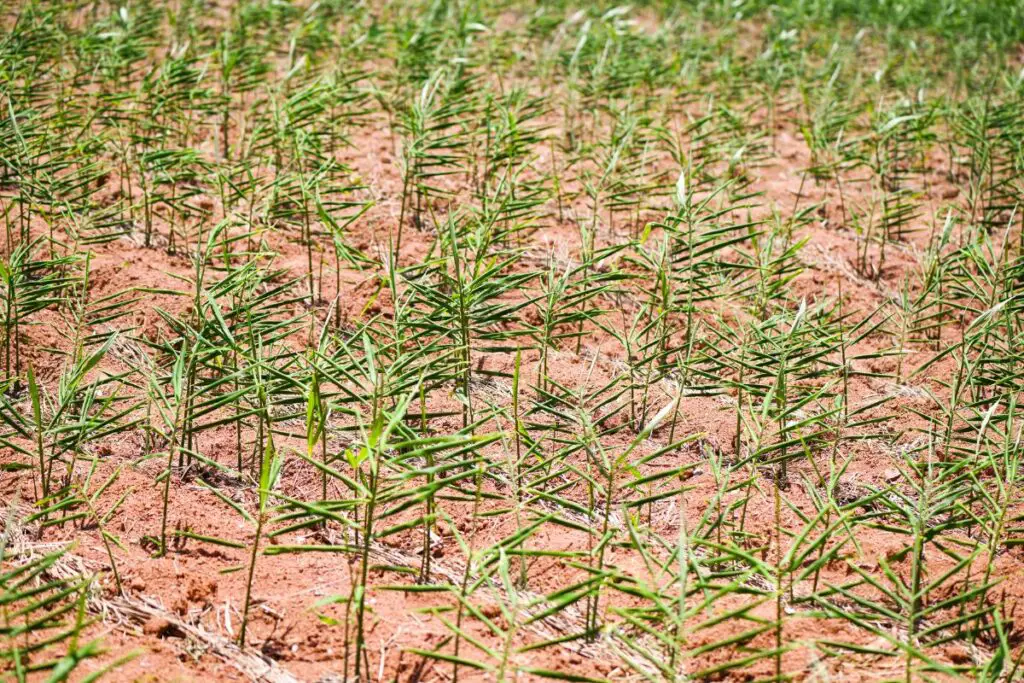
Though ginger plants are grown for their rhizomes, they also have aromatic flowers.
But when the flowers don’t appear, there are some issues.
Lack of sunlight
Indeed, ginger plants cannot stand direct sunlight.
But, at least 2-5 hours of direct sunlight is not harmful.
This much light is enough for gingers to produce flowers.
If it is not flowering, they are not getting adequate sunlight.
Winter damage
Since gingers are tropical plants, they hate cold weather.
If your ginger plants are exposed to temperatures below 50°F for a long time, the plant won’t flower.
Cold climate
If you live in colder climates, the ginger plants don’t flower very often.
It is because the sunlight is not enough for them.
The light has to be in the proper amount with proper intensity.
Lack of nutrition
Since gingers are heavy feeders, low feeding causes malnutrition.
It further affects flowering.
Fertilize your plant properly and take good care of them to witness flowering.
Also read: Why Is My Ginger Plant Not Flowering? (8 Causes+Fix)
7. Ginger plant has a pest infestation
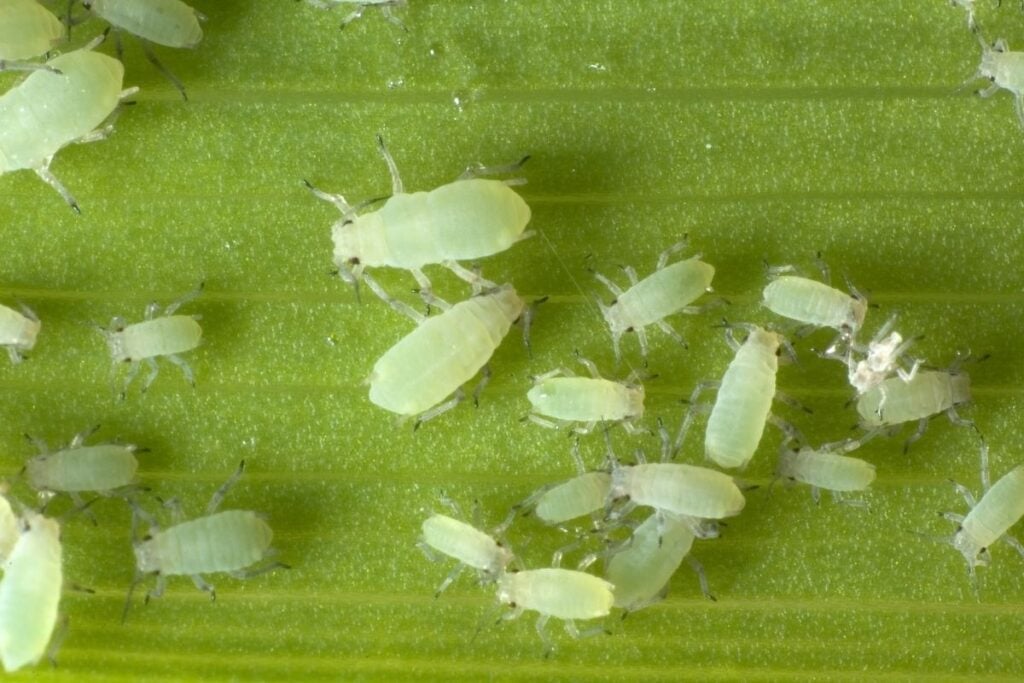
Ginger can get attacked by a lot of pests.
Let’s go through some of them:
Shoot borer
The larvae of this pest stay in the stems and feed on the tissues of the stems.
As a result, it causes yellow and dry leaves.
The infestation symptoms include holes in the stems and dry yellow leaves.
The pests thrive best when the temperature is around 80-90°F and humidity is 70-90%.
You can spray Neem oil on the affected areas to fix the problem.
Please find out the infested shoots to bring out the bugs and kill them.
Apply Metarhizium or Beauveria bassiana mixed with 10g per liter of water.
Leaf roller
The damage signs are leaves folded and rolled longitudinally.
In severe cases, the plant will lose all the leaves.
The favorable conditions are high temperature and high humidity levels.
To fix the problem, sanitize the field before planting the ginger rhizomes.
Apply some Bacillus thuringiensis 1-2 gm mixed with 1-liter water.
Chinese rose beetle
The leaves will have holes and get skeletonized, except for the veins.
Give the gingers some hours of direct sunlight to eliminate these beetles.
Use LED lights if needed.
Cover the young plants with floating row covers to save them from getting attacked.
Thrips
These insects feed on the sap of the leaves and create holes in the leaves.
The leaves get rolled up, yellowish, and dry.
In worst cases, the young plants will tile and dry out.
You can try Neem oil or several insecticides to eliminate the pests.
Apply 50% of Dichlorvos or 40% Dimethoate.
Control weed growth.
Introduce natural predators like Roberfly or flower bugs.
Thrips enjoy warm and dry weather.
Use it as an advantage and keep the ginger plants consistently moist.
Rhizome scales and flies
The scales feed on the plant sap and turn the rhizomes shriveled and dry.
The leaves fall off.
You can either hand pick these scales or use neem oil to deter them.
Shake off the plant a little if there is any thin layer of white powder.
It is the pupa, and it gets dislodged if disturbed.
The flies feed on the rhizomes of ginger and cause yellow leaves and rotten rhizomes.
The flies prefer warm and humid climates.
Mix soap, water, sugar, and vinegar and add some to the infected areas.
Aphids
Aphids suck the plant sap and leave the plant malnourished, discolored, and dry.
They enjoy prolonged wet conditions.
The leaves become yellow or brown, the rhizomes don’t develop well, and the plant deforms under severe conditions.
To prevent aphids, avoid overwatering.
Spray Neem oil over the affected areas.
Release predators like ladybugs and lacewings.
But you can’t use general insecticides here.
Dislodge the aphids with forceful watering.
Slugs
These feed on the leaves at night and hide in the soil crevices during the day.
They enjoy prolonged moist conditions.
Slugs eat the leaves and rhizomes, thus preventing rhizome maturation.
To encounter these bugs, handpick them at night or early morning.
Set traps with beer cans or release natural predators like ground beetles, birds, or snakes.
Spread diatomaceous earth over the soil.
8. Ginger diseases
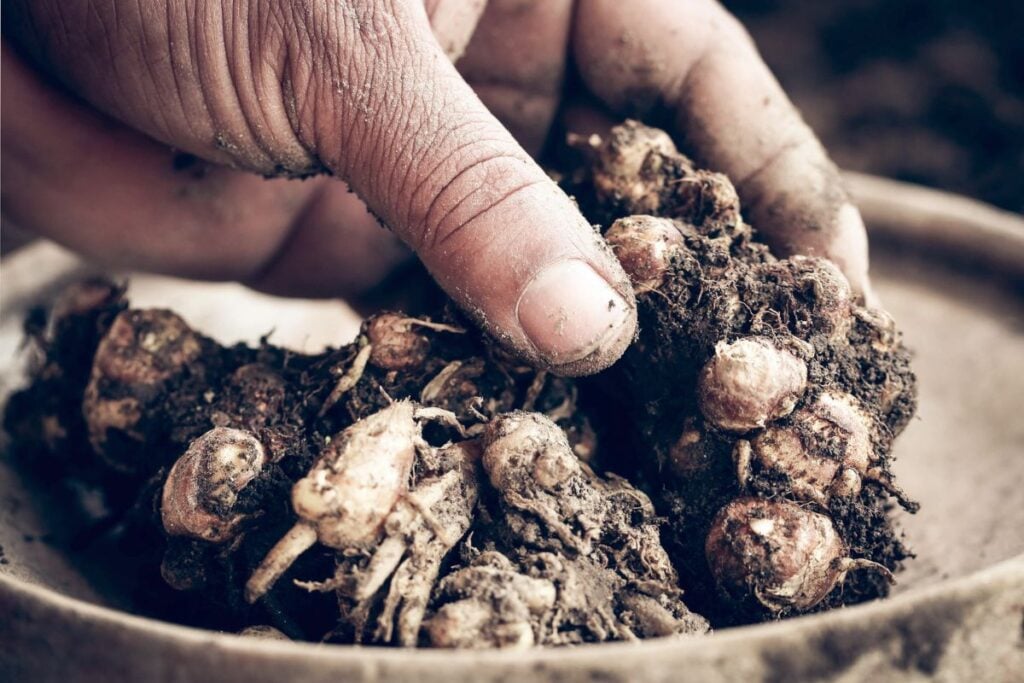
We have already shared some diseases like bacterial wilt, fusarium yellow, dry out, and rhizome rot.
Other diseases are:
Ginger leaf spot
The disease creates yellow or white spots around 2-5 cm long.
The center of the spots is thin and papery.
When the disease progresses, the spots spread all over the leaves.
Consider crop rotation every 2-3 years.
Avoid using high nitrogen fertilizer.
Use the one with 10-20-20 NPK.
Mosaic Viral disease
The disease causes dark green or yellow mosaic spots on the leaves.
Slowly the leaf growth will stop, and the rhizomes will get infected.
Before planting, treat the seeds or rhizomes with hot water at 113-122°F for 3,6. And 12 hours.
Root-knot nematode disease
It is a skin disease where the pathogens feed on the young rhizomes.
The plant shows stunted growth, chlorosis, and marginal necrosis.
The rhizomes start rotting and have brown water-soaked marks on their bodies.
Use chloropicrin fumigation or nematicidal isopropyl ether around 3 kg in the planting soil.
Solarize the ginger planting beds for 40 days before planting.
Final thoughts
There might be more, but these problems are the most common ones in ginger plants.
Once you see the signs and identify the problem at the initial stage, your job is to terminate the problem to prevent it from spreading.
Sometimes precaution is the only way.
Reference: Ginger Production, Texas AgriLife Extension, USDA, Wikipedia
